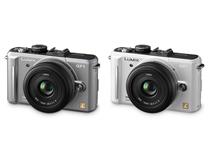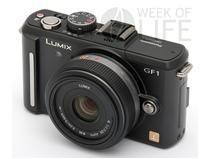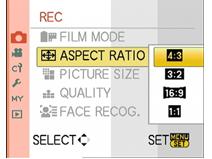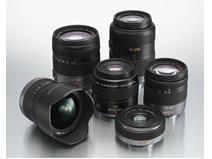Given that in our review, we declared the Olympus Pen E-P1 a legend the moment it was introduced, the Panasonic Lumix DMC-GF1 can be labeled ‘another one’. Actually, it is a direct competitor to the Olympus and as a matter of fact, only the second model of this new concept of professional compacts with exchangeable optics.
The Lumix DMC-GH1 followed the Olympus, however, and for the sake of accuracy it must be noted that Panasonic was the first manufacturer to use the Mirco 4/3 standard, which includes both the Olympus Pen as well as the Lumix GF1, with the introduction of the Lumix DMC-G1 and GH1 models. However, these cameras remind us too much of reflex cameras and represent a rather different development branch of the Micro 4/3 standard.
 |
 |
Whereas Olympus went retro with its Pen, the Panasonic kept Lumix GF1 has a typical austere design, though livened up with an unusually large choice of colors. Apart from the undifferentiated black or silver, you can choose red or white finish for the metal coated body.
| Panasonic Lumix DMC-GF1 – in short | |
| Resolution | 12 Mpx |
| Optics | depending on the lens |
| Video | HD (1,280 × 720 px) |
Another point of comparison between the Lumix GF1 and the Olympus Pen, is that the dimensions are nearly the same, that is, if we ignore the fact that the body of the Lumix is three millimeters shorter. The weight of the Panasonic is a twenty or thirty grams lighter than the Pen, however, if you weigh both cameras with mounted Pancake lenses, you will find that the scales balance out (the Lumix lens is heavier). With respect to size and weight it is thus a camera that ranks on the border between compact devices and amateur reflex cameras.
 |
 |
Because it is a state of the art device for demanding users, the top and especially the back side of the Lumix GF1 carry a rather considerable number of control elements. In this respect, the camera is comparable to reflex cameras, which of course applies also to control comfort, as many important functions have their own control elements for direct access.
Praise should be given to the LCD display. The resolution of 460 thousand pixels is highly above standard and the LCD demonstrates this right away. In particular, the sharpness and fine detail rendering are excellent. With this display you will easily detect even a slightly blurred image.
 |
 |
Panasonic equipped its professional compact Lumix GF1 with what many critics reproach Olympus Pen for – a built-in flash and an option to mount an electronic viewfinder. At first sight this may seem an obvious advantage, however both have their pros and cons. First, the pop-up flash is very weak. The output expressed with the informative figure GN6 is sufficient for a reach of literally only a few meters, and only with a low aperture set. The flash cannot be meaningfully used for clearing shadows in daylight because it does not enable high-speed synchronization – the shortest available time is 1/180 s.
Regarding the external viewfinder mounted to the flash hot shoe on the Lumix GF1, this has the definite advantage of working with any lens; it is able to ‘screen’ many exposition details including the histogram, among others, and it is possible to tilt the viewfinder up to 90 degrees. Disadvantages include a rather low resolution of approximately 200 thousand pixels, small enlargement (image size), and last but not least a price of $900.
| Super features |
| Top image quality |
| Functions |
| Color finish of the body |
| Option to use EVF viewfinder |
| Good selection of optics |
As mentioned earlier, Panasonic was in fact the first company that introduced devices of the Micro 4/3 standard to the market. With this also comes a larger selection of lenses compared to Olympus. Panasonic has in its portfolio not only standard zoom but also tele zoom, macro lens, wide zoom, and 10x zoom. Both brands are in terms of the Micro 4/3 standard mutually compatible, thus it is possible to use optics from both brands. Moreover, there exist various adapters for the Micro 4/3 cameras that allow the use of other lenses, perhaps even the legendary optics Leica M. In the context of Lumix GF1 optics, another difference from Olympus Pen E-P1 should be noted. Whereas Pen is equipped with a stabilized sensor in the body – that is, a universal solution thanks to which vibration is smoothed down with any mounted lens, Lumix uses stabilization in optics. Thus if a lens does not have Mega O.I.S. stabilizer (e.g. Lumix G 20 mm F1,7), you must rely on a firm grip or shorter shutter speeds..
Screenshots of the menu of Panasonic Lumix DMC-GF1
 |
 |
 |
 |
 |
 |
Overall evaluation
Panasonic Lumix DMC-GF1 is an excellent device for demanding photographers, which, just as its sole competitor, Olympus Pen, offers the quality of a reflex camera in the body of a slightly larger compact camera. The option of changing lenses is of course priceless, handling is comfortable, and the device has a high-speed response during automatic focusing and capturing.
Common price (at the time of this review’s publication):
Kit including Lumix G Vario 14–45 mm F3.5–5.6 lens: $900
Kit including Lumix G 20 mm F1.7 lens: $900
Electronic viewfinder DMW-LVF1: $197
Basic technical data
Sensor
Live MOS 17.3 × 13 mm
12 Mpx (4,000 × 3,000 px)
Sensitivity ISO 100 to 3,200
Optics
Depending on the lens
Memory medium
SD, SDHC
Data formats
Image: JPEG, RAW
Video: MOV, AVCHD
Video
1.280 × 720 px, 25/30 fps
848 × 480 px, 30 fps
640 × 480 px, 30 fps
320 × 240 px, 30 fps
Mono sound
LCD
Screen size 3” (76 mm)
460,000 px
Power supply
Li-Ion battery
Dimensions and weight (body only)
119 × 71 × 35 mm (w × h × d)
345 g (incl. battery and memory card)
 |
 |
 |
 |
 |
 |
 |
 |
 |
 |
 |
 |
 |
 |
 |


